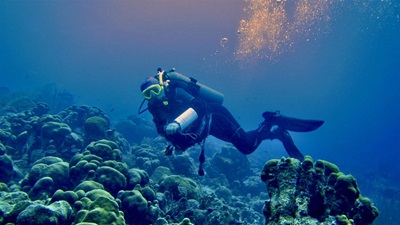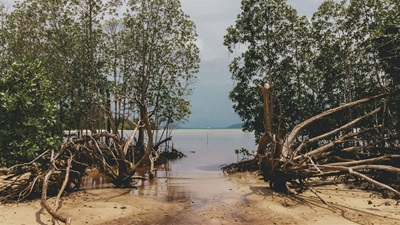To Help Save Atlantic Goliath Grouper, Researchers Turn to Local Fishers
By tapping coastal communities’ ecological knowledge, Pew marine fellows hope to reshape management of highly vulnerable fish

The Atlantic goliath grouper, which can weigh up to 800 pounds and measure over six feet long, is at risk of extinction. Overfishing and poaching in tropical latitude areas of the Atlantic have devastated populations of this slow-moving giant, known for a curious nature that makes it highly vulnerable to hook-and-line and spearfishing. Harmful algal blooms, often fueled by land-based pollution, and the destruction of key juvenile habitats such as mangroves have also taken a toll on the species.
Now, a team of Pew marine fellows is working to reverse that trend, combining historical data with local ecological knowledge and citizen science in hopes of helping this iconic fish recover.
“We hope the goliath grouper can be a symbol of how people can use knowledge to create a more restorative relationship with nature,” said 2011 Pew marine fellow Andrea Sáenz-Arroyo, who is leading the collaborative project with several other Pew fellows, including Rachel T. Graham (2021), Fabían Pina Amargós (2012), and Felicia C. Coleman (2001).
From abundance to absence
As top predators, Atlantic goliath groupers play an important role in balancing the marine ecosystems they live in. Typically found in coral reefs, rocky outcroppings, and shipwrecks, adults migrate seasonally to specific spawning sites, many of which remain undocumented by science but are well known to local fishers.
At these sites, the groupers—sometimes numbering more than 100—gather in the same place at the same times to breed. This behavior is thought to increase mating opportunities and benefit larval survival by overwhelming predators. However, the predictability of these events makes the species easy to target by fishers, putting many reproductive-age individuals at risk at once.
Goliath grouper populations have been declining since the 1950s, according to a 2021 study co-authored by Sáenz-Arroyo and published in the journal Endangered Species Research, primarily because of overfishing and the destruction of mangroves, which are critical nursery habitats. While the population in the southeastern United States has shown signs of recovery following a fishing moratorium enacted in 1990, the study authors explain that other countries, including Mexico and Belize, have not seen the same progress. Even where fishing bans exist, such as in Brazil and Cuba, illegal harvesting continues at concerning levels.
As Sáenz-Arroyo and her co-authors wrote, efforts to protect goliath groupers have been hindered by a lack of reliable, region-specific data. Outside of the U.S. and Brazil, few countries have conducted formal stock assessments for the species, making it difficult to determine the population’s status or implement sustainable management practices to support its recovery.
Traditional knowledge as a lifeline
Local ecological knowledge (LEK), drawn from the observations and experiences of fishers and coastal communities, has become an essential resource in filling these information gaps. Fishers’ knowledge has contributed significantly to understanding goliath grouper behavior, interactions with other species, and migration patterns. LEK has also provided valuable insights into where the fish spawn, how various fishing gear affect habitat, and the effectiveness of conservation strategies.
The LEK included in the study is “gleaned from decades of fishing, knowledge that [fishers] had earned from their fathers, uncles, grandfathers, and more,” said Graham, the 2021 fellow, who has worked with local fishers on goliath grouper in Belize since 2005 and is collaborating with Sáenz-Arroyo on the project. “If you don’t know your history, you’ve got a shifting baseline. You need oral histories to help you set realistic restoration goals.”
In many coastal communities, the goliath grouper has been part of the cultural fabric for decades or longer. Stories about the species are passed down like folklore.
Sáenz-Arroyo, Graham, and their collaborators are rethinking both conservation strategy and who shapes it. That means elevating LEK as a legitimate source of information that can support vital conservation actions, including identifying and protecting spawning aggregations.
“If people see their knowledge reflected in scientific outputs and outcomes, there’s a greater likelihood of long-term stewardship,” Graham said. “We want to make sure that people have a right over their conservation and management and that they see themselves reflected in decisions.”
Nathan Fedrizzi works on the Pew Fellows Program in Marine Conservation.







